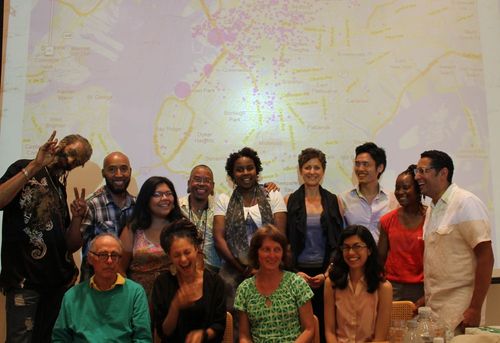Partnering with NYCHA for GO
GO is a project that’s rooted in community, but “community” is one of those words that can have a lot of different meanings. As Sharon and I conceptualized GO, we thought a lot about this—how is community defined for a project happening within the incredibly diverse communities of Brooklyn? There are some obvious answers here—we’ve talked about going local and how important that has been for the project, but we started to ask ourselves, what are the things that are unique to the communities of Brooklyn where artists are working?
In looking at the areas with the highest concentrations of artists, we noticed that studio buildings are quite often right next door to housing developments managed by the New York City Housing Authority (NYCHA).

As a resident of Red Hook, I see this every day. With 157 artists registered to open their studios for GO (purple dots on this image), some are a stone’s throw from the Red Hook Houses, the largest NYCHA housing development in Brooklyn, seen here in satellite view.
This proximity is something that felt unique to Brooklyn and the communities that GO would directly be engaging. We wanted to insure that GO would be a project open to every resident in Brooklyn, including residents of NYCHA housing. Working with our Vice Director of Education, Radiah Harper, we reached out to Sharon Myrie, Juan Santiago, and Wiley Lucero at NYCHA to see if they would partner with us; everyone was incredibly supportive of GO and the opportunity to bring these communities closer together. Our partnership also tied in with NYCHA’s new initiative, Plan NYCHA, as well as aligned with the work they had been doing with StudioNYCHA and continued an existing partnership with the Brooklyn Museum.

As Sharon and I researched open studios, one of the artists we visited in Red Hook said he really liked the open studio model because, for him, it was full of surprises. One year, his door was open and a group of kids from the Red Hook Houses came in to visit. He said he had the best time with this group and, even though his studio is just a block away from the housing development, he felt like he often didn’t have a chance to engage with his neighbors this way and his open studio allowed that kind of exchange to take place. Seen above, the Red Hook Houses sit right beside studio buildings in the area.
Over the spring and early summer, we worked together to develop a plan, and, as a result, Maya Valladares, GO’s Project Educator, is managing a team of ten teaching artists who will lead art walks during the open studio weekend. Walks will start from community centers in five NYCHA developments: Wyckoff Gardens (Gowanus/Boerum Hill), Red Hook Houses (Red Hook), Cooper Park (East Williamsburg/Greenpoint), Bushwick-Hylan (Bushwick), and Lafayette Gardens (Clinton Hill/Bedford Stuyvesant). As part of this partnership, NYCHA will be opening these community centers on Sunday for the first time and, not only will walks be based out of these locations, NYCHA will be offering art activities for residents.

Teaching artists working on the GO NYCHA partnership include: (back, from left) Veron Israel Williams, Joseph H. Falero, Paula Santos, Taeesha Muhammad, Edyta Halon, Pansum Cheng, Keneisha Turner, Juan Santiago, (front from left) Wiley Lucero, Maya Valladares, Laurel Shute, Melinda Yale.
As part of this program, teaching artists from the Brooklyn Museum have been paired with teaching artists from NYCHA staff. Each pair is reaching out to the NYCHA community centers, residents of the houses, and grassroots organizations to help get the word out about the collaboration. The pair will lead the walks during the weekend and participants will check-in and nominate artists using an iPad app specifically designed for these walks. When the GO exhibition opens in December, we will continue to work with NYCHA so participants can attend the opening and take in the show they helped create.
The programming we are doing in collaboration with NYCHA is something that our corporate sponsor, Deutsche Bank, really encouraged. Deutsche Bank is supporting GO through its Art & Technology program and in their own participation, they wanted to support an initiative that thought broadly about community and sought to enable all residents of Brooklyn access to both the process and the technology that would be used throughout.

Shelley Bernstein is the former Vice Director of Digital Engagement & Technology at the Brooklyn Museum where she spearheaded digital projects with public participation at their center. In the most recent example—ASK Brooklyn Museum—visitors ask questions using their mobile devices and experts answer in real time. She organized three award-winning projects—Click! A Crowd-Curated Exhibition, Split Second: Indian Paintings, GO: a community-curated open studio project—which enabled the public to participate in the exhibition process.
Shelley was named one of the 40 Under 40 in Crain's New York Business and her work on the Museum's digital strategy has been featured in the New York Times.
In 2016, Shelley joined the staff at the Barnes Foundation as the Deputy Director of Digital Initiatives and Chief Experience Officer.
